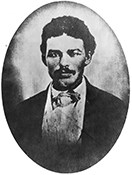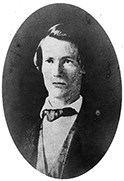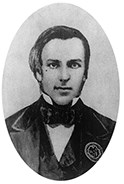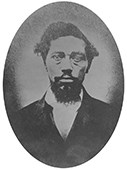I am dying for freedom. I could not die for a better cause. I had rather die than be a slave. Raider John A. Copeland Jr., December 16, 1859, the day of his execution
Article
"I had rather die than be a slave"
Twenty-one men and two women joined John Brown in the raid on Harpers Ferry — twenty-three individuals with different backgrounds and occupations. Some were rich, others poor; some black, others white; some born free and others enslaved since birth. These men and women with many differences joined in one common goal — to end slavery. Knowing the risks, some fought and others provided support. Sixteen gave their lives with the hope that four million enslaved people would one day be free.

Library of Congress
August 15, 1834 - December 16, 1859
Copeland, a free African American, was a student at Oberlin College in Ohio and a nephew of Raider Lewis Leary. Captured during the raid, his conduct at his trial impressed Judge Richard Parker and Prosecutor Andrew Hunter to the extent that they would have pardoned him, had it been an option. Copeland was tried and hanged in Charles Town.

Library of Congress
March 17, 1835 - October 18, 1859
Leary, a free African American, left a wife and baby to fight against slavery. He and his nephew, John Copeland, joined Brown on October 12. After rounding up hostages, he was ordered to hold the U.S. Rifle Factory. He was mortally wounded while retreating across the Shenandoah River on October 17 and died ten hours later.

Library of Congress
July 27, 1830 - December 13, 1872
A free African American living in Canada, Anderson worked for the Provincial Freeman newspaper in Chatham when he met Brown at the Chatham Convention. He escaped after the raid by walking through the mountains into Pennsylvania and taking trains to Canada. He penned A Voice from Harpers Ferry in 1861 and was a recruiter for the Union army in 1864. Osborne Anderson died of tuberculosis in Washington, D.C.

Library of Congress
March 9, 1838 - October 18, 1859
At twenty-one, Oliver was the youngest of Brown's sons to join the raid. He fought with his father and brothers in Kansas. Oliver and his wife, Martha, traveled to the Kennedy Farm in Maryland to help prepare for the raid on Harpers Ferry. He was mortally wounded on October 17 and died on the 18th.
Martha Brown
Married to John Brown's son Oliver, seventeen year old Martha and her sister-in-law Annie Brown provided support for the raiders. The women's presence gave the cover of a normal household at the Kennedy farm staging area. A few weeks before the raid, Brown sent Martha and Annie home.
Married to John Brown's son Oliver, seventeen year old Martha and her sister-in-law Annie Brown provided support for the raiders. The women's presence gave the cover of a normal household at the Kennedy farm staging area. A few weeks before the raid, Brown sent Martha and Annie home.

Library of Congress
December 23, 1843 - October 5, 1926
Annie Brown was the youngest of John Brown's daughters. At just 15 years old, she joined her father at the Kennedy Farm in 1859 prior to the raid on Harpers Ferry. Her job was to remain watchful for neighbors and alleviate their suspicions. Brown sent Annie and her sister-in-law Martha home a few weeks before the raid. Annie died October 5, 1926 and was buried in Shively, California.

Library of Congress
November 4, 1824 - January 9, 1889
Named for his grandfather, Owen fought with his father in Kansas and at Harpers Ferry. Appointed Captain in Brown's Provisional Army, he guarded rifles and pikes, waiting to arm others who came to join the fight at "the ferry." His determination and great physical strength helped four raiders escape from Harpers Ferry. After several years in Ohio, he moved to California with other family members and died there.

Library of Congress
October 7, 1835 - October 19, 1859
During the "Bleeding Kansas" years, Watson worked the family farm in North Elba, New York, while his father and brothers fought against the spread of slavery in Kansas. Four years later he decided to join his father in Harpers Ferry. Leaving a wife and baby, he traveled to Harpers Ferry. Watson was mortally wounded on October 17 while carrying a white flag. He died on October 19 after the raid had ended.

Library of Congress
May 12, 1829 - December 16, 1859
Cook came from a well-to-do family and studied law in New York before joining Brown in Kansas to fight against slavery. An advance man for Brown, Cook moved to Harpers Ferry more than a year before the raid. He taught school and married Mary Virginia Kennedy, a local girl. Gathering supplies during the raid, Cook was stranded on the Maryland shore. He traveled north with other raiders, but was captured in Pennsylvania and tried and hanged in Charles Town on December 16.

Library of Congress
January 4, 1839 - September 3, 1861
Brother of Raider Edwin Coppoc, Barclay gave up his mother's Quaker beliefs and used violence to end slavery. As a rear guard, he never entered Harpers Ferry and was able to escape. He became a first lieutenant in the Third Kansas Infantry on July 24, 1861. He was mortally injured on September 2, when his troop train plunged into the Platte River after Confederates had burned the trestle supports. He died the next day.

Library of Congress
June 30, 1835 - December 16, 1859
Brother of Raider Barclay Coppoc, Edwin probably shot and killed Harpers Ferry Mayor Fontaine Beckham. He was captured in the engine house, tried, and sentenced to hang. The night before their execution, he and John Cook nearly escaped from the Charles Town jail. He was hanged on December 16, 1859 in Charles Town.

Library of Congress
circa 1836 - December 16, 1859
Born into slavery in South Carolina, Green escaped, finding freedom in Canada. In Rochester, NY, he worked as a servant and clothes cleaner and met Frederick Douglass. Douglass introduced Green to Brown and he decided to "go with the old man." He was captured in the Armory engine house, tried, and hanged on December 16 in Charles Town.

Library of Congress
September 21, 1837 - March 16, 1860
Hazlett fought in Kansas with the Free State forces and joined Brown there in 1858. He and Osborne Anderson held the U.S. Arsenal during the raid, escaping when their situation seemed hopeless. He was caught near Carlisle, Pennsylvania, on October 22, 1859. He was tried and later hanged on March 16, 1860, in Charles Town.

Library of Congress
March 15, 1835 - October 17, 1859
Kagi was a self-educated, intelligent man who developed a hatred of slavery while teaching in Virginia. Brown's most trusted lieutenant, he tried to convince Brown to take the battle to the surrounding hills. Brown refused. Kagi was in charge of the U.S. Rifle Factory during the raid. Grossly outnumbered, he was shot and killed while trying to escape across the Shenandoah River.

Library of Congress
March 20, 1839 - October 17, 1859
At age 17, Leeman left a job in a shoe factory in Massachusetts and moved to Kansas with a group of anti-slavery settlers. There he became a member of Brown's "Volunteer Regulars." During the raid on Harpers Ferry, he was shot and killed while attempting to escape across the Potomac River.

Library of Congress
November 17, 1837 - November 28, 1865
Despite his frailty and blindness in one eye, Meriam's hatred of slavery made him determined to join Brown. He served as Brown's rear guard in Maryland and escaped Harpers Ferry. During the Civil War, he served as a captain in the Third South Carolina Colored Infantry.

Library of Congress
ca. 1820 - October 17, 1859
Enslaved since birth, Newby was born to a white father and an enslaved mother. In 1858, Newby's father moved the family to Ohio, where they gained their freedom. Already in his late 30s, Newby was a husband and father whose wife and children were enslaved to another man in Virginia. Newby raised money to buy his family, but the man who enslaved them refused to sell. To free his family, Newby joined Brown. Newby was the first raider to be killed in Harpers Ferry. Desperate letters from his wife pleading for Newby to rescue their family were found on his body. She and their children were sold after his death.

Library of Congress
1831 - March 16, 1860
Stevens, a soldier in the Mexican War, had escaped from Fort Leavenworth after attacking an officer. He joined Brown in Kansas and followed him to Virginia. Wounded while carrying a flag of truce, he was carried by Joseph Brua, one of Brown's prisoners, to a nearby hotel. He was later tried and hanged on March 16, 1860, in Charles Town.

Library of Congress
October 29, 1836 - October 17, 1859
Born at Uxbridge, Canada, Taylor discovered a common bond with Brown in their hatred of slavery. Brown's daughter, Annie, described Taylor in this way: "He considered it his duty to go to Harpers Ferry, and he did, although he knew he was going to his end." Taylor was killed defending the engine house on October 17.

Library of Congress
April 17, 1838 - October 18, 1859
Dauphin was the youngest of 18 children and the younger brother of Raider William Thompson. On October 18, Thompson was trapped in the Armory engine house after the Marines stormed the building. He died from a bayonet thrust.

Library of Congress
August, 1833 - October 17, 1859
The Thompson brothers were neighbors of the Brown family in North Elba, NY. An angry mob seized William while he was carrying a flag of truce and held him captive in a nearby hotel. On October 17, after Mayor Fontaine Beckham was killed, the mob dragged William out to the railroad bridge and shot him in the head. They threw his body into the river and used it for target practice.

Library of Congress
circa 1834 - February 8, 1862
Tidd, a veteran of the Kansas Wars, had been with Brown since 1857. After the raid began, Tidd went back to Maryland for weapons and supplies. He joined four other raiders and escaped. He enlisted in the Twenty-First Massachusetts Volunteers on July 19, 1861. He died of fever on a troop ship on February 8, 1862.

Library of Congress
April 17, 1833 - October 18, 1859
A grandson of a Virginia enslaver, Anderson lived in Illinois and Iowa before moving to Kansas in 1857. He fought with the Free State forces and joined Brown on a raid to free enslaved people in Missouri in 1858. Trapped with Brown, he was bayoneted by a Marine during the final assault on the Armory engine house. He died a few hours later.
Last updated: August 30, 2021
